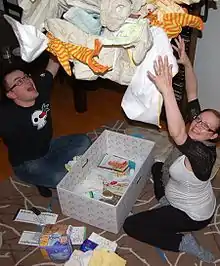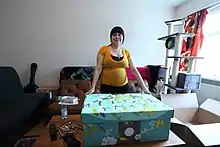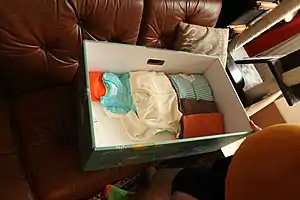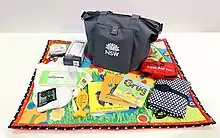Maternity package
The Maternity package (Finnish: äitiyspakkaus, Swedish: moderskapsförpackning) is a kit granted by the Finnish social security institution Kela, to all expectant or adoptive parents who live in Finland or are covered by the Finnish social security system. The package contains children's clothes and other necessary items, such as nappies, bedding, cloth, gauze towels and child-care products.[1] It was first issued in 1938[2] to parents with a low income, and contained a blanket, crib sheets, diapers, and fabric which parents could use to make clothing for the baby.[3]


Since 1949 it has been given to all mothers-to-be, provided they visited a doctor or municipal pre-natal clinic before the end of their fourth month of pregnancy, and the pregnancy has lasted at least 154 days.[4] The contents of the package are updated approximately every year.[5] A mother may choose to take the maternity package, or a cash grant of 170 euros, but 95% of Finnish mothers choose the box because it's worth significantly more.[6] Between 2006 and 2019, the total maternity grant program cost an average of 10.3 million euros per year, with 7 million being spent on maternity packages and 3.3 million given out as cash benefits or adoption grants. The maternity packages each year cost between 183 and 223 euros, averaging 190 euros each over the full 15-year period; an average of 37,000 are given out each year.[7]
Following a BBC story in June 2013, the baby box began to receive international attention. Similar packages, commercial or state-sponsored, are being trialled around the world. Private companies have started selling packages purporting to be the "Finnish baby box" or similar to it, but the original boxes are not sold commercially.[8]
Package

In 1949, the box given was standard to all expectant mothers who visited a doctor before the fourth month of pregnancy[3] per the Finnish Maternity Grants Act. A baby bottle was added to the package, but was removed in later packages to encourage breastfeeding.[3][9] The requirement to visit a doctor as a prerequisite to receiving the package was done in order ensure that the woman received adequate prenatal care.[6] The maternity package can either be applied for online, on Kela's website, or by completing and returning a form.[5]
The current package contents include bodysuits, a sleeping bag, outdoor gear, bathing products for the baby, nappies and cream, bedding, a hooded bath towel, nail scissors, hairbrush, toothbrush, wash cloth, muslin squares, a picture book, teething toy, bra pads, and condoms.[10] It also contains a small mattress, allowing the box containing the package to become a crib in which many newborns have their first naps.[6][11] Condoms are included by way of precaution, not as a discouragement, as a new pregnancy is possible within a few weeks of childbirth and many parents wish to have a little time between the births of their children.[12]
The maternity package is not a commercial product, and therefore Kela cannot sell it.[5] Prince William and Catherine, Duchess of Cambridge received a maternity package as a gift from Kela in 2013. Crown Princess Victoria and Prince Daniel of Sweden were given one in 2012.[4]
Content of the package in 2017
In 2017 the box contained following items:[8]
- Snowsuit / sleeping bag 68–74 cm (27–29 in)
- Insulated mittens and booties
- Sleeping bag / blanket 95 cm × 95 cm (37 in × 37 in)
- Light-weight overall with hood 68–74 cm
- Wool-blend coverall 68–74 cm
- Wool cap
- Balaclava hood 62–68 cm (24–27 in)
- Cap
- College overall / jumpsuit 62–68 cm
- Romper suit 50–56 cm (20–22 in)
- Wrap around body suit 50–56 cm
- Bodysuit with extender 62–68 cm
- Bodysuit 68–74 cm
- Bodysuit 62–68 cm
- 2 × Wrap around bodysuit 50–56 cm
- 2 × Leggings 62–68 cm
- 2 × Leggings 68–74 cm
- 2 × Footed leggings 50–56 cm
- Tights 62–68 cm
- Socks and mittens 19–21
- Socks 19–21
- Sleeping bag / nightdress 62–68 cm
- Bedding and linen
- Blanket, off-white 80 cm × 120 cm (31 in × 47 in)
- Duvet cover with pattern of baby footprints on green background 85 cm × 130 cm (33 in × 51 in)
- White sheet 90 cm × 150 cm (35 in × 59 in)
- Protector 90 cm × 150 cm (can be used, for instance, as protection for the mattress)
- Mattress 700 mm × 428 mm × 40 mm (27.6 in × 16.9 in × 1.6 in)
- Pocket nappy and cotton gauze insert
- Towel 85 cm × 85 cm (33 in × 33 in)
- Personal care items (bra pads, nail scissors, toothbrush, digital thermometer, talcum powder, nipple cream, condoms (6pcs), lubricant, sanitary towels, bath thermometer, hairbrush)
- Feeding bib
- Drooling bib / scarf
- First book titled "Lystileikit vauvan kanssa” in Finnish and Swedish
- Cuddly toy / comfort blanket
Effects
There is no evidence that the baby box has lowered infant mortality in Finland. However, there is great promise for the baby box's potential in public health, with reports soon forthcoming on this topic from Finnish research groups.[13] The program is now considered a part of the culture of Finland.[9]
As of June 2019, there had been one experimental study[14] conducted on the use of baby boxes (a.k.a., "cardboard bassinets"), in combination with safe sleep education, for reducing bed-sharing, which is a risk factor for sudden infant death syndrome (SIDS) and sleep-related deaths (SRD). Researchers at Temple University Hospital assigned study participants (i.e., mother-infant dyads) to one of the following conditions for postpartum hospital discharge: standard hospital discharge instructions; standard instructions plus additional safe infant sleep education based on the AAP safe infant sleep recommendations; or both types of instruction plus a gifted baby box from The Baby Box Company. The researchers concluded that the third condition (i.e., both types of instruction plus a gifted baby box) reduced the rate of bed-sharing during the first week of the infant's life (as self-reported by the participating mothers), particularly for exclusively breasfeeding mother-infant dyads.
Similar programs in other countries
Argentina
In July 2015, Argentina's Ministry of Health under then-president Cristina Fernandez de Kirchner introduced "Plan Qunita" which distributes maternity packages to parents of newborn babies. At the rollout of the program, about 144,000 Qunitas were issued.[15][16]
Australia

In Australia, the state of New South Wales began a program providing a baby bundle to the parents of every baby born from 1 January 2019. The bundle contains picture books, mats, a first aid kit, a sleeping bag, thermometers, and consumable child-care products such as cloths and wipes, with a total retail value of AU$300.[17]
Similarly, the state of Victoria began a baby bundle program starting from July 2019, for all first-time parents and carers.[18]
Canada
In 2016, a program modeled on the Finnish baby box concept was launched in the northern territory of Nunavut, as a way of combatting its high infant mortality rate.[19]
Scotland
A similar scheme in was introduced in Scotland in 2017. After a three-month pilot scheme in Clackmannanshire and Orkney, the Scottish "baby box" began to be issued to all parents with newborns in summer 2017,[20] with over 52,000 such boxes issued in the first twelve months of the programme.[21]
United States
In the summer of 2017, it was announced that the U.S. state of New Jersey would become the first state in the country to adopt the baby box program.[22]
See also
- Layette, a collection of infant clothing prepared (made, bought, or given) during pregnancy
Notes
- Kela: Maternity package.
- Korppi-Tommola 2006, p. 15.
- United Press International 2013.
- BBC 2013.
- Kela: Maternity grant.
- Lee 2013.
- Kela. "Statistics on the maternity grant". kela.en. Retrieved 18 May 2020.
- "Maternity package". www.kela.fi. Retrieved 2 November 2017.
- Tierney 2013.
- "Royal baby: William and Catherine get Finnish baby box". BBC News. 2013-07-02. Retrieved 2014-07-08.
- Lee, Helena (2013-06-04). "Why Finnish babies sleep in cardboard boxes". BBC News. Retrieved 2014-07-08.
- "Frequently asked questions about the Finnish maternity package". Kela – Maternity package. Retrieved 2019-07-25.
- https://research.uta.fi/babybox/
- Heere, Megan; Moughan, Beth; Alfonsi, Joseph; Rodriguez, Jennifer; Aronoff, Stephen (2019). "Effect of Education and Cardboard Bassinet Distribution on Newborn Bed-Sharing". Global Pediatric Health. 6: 1–9. doi:10.1177/2333794XI9829173.
- "Qué es el plan Qunita que anunció hoy la presidenta Cristina Kirchner". LA NACION (in Spanish). 16 July 2015. Retrieved 5 August 2018.
- "The scandal around baby crib handouts, or, 'The Qunita Plan,' explained". The Bubble. 2016-02-17. Retrieved 2016-09-26.
- "Baby Bundle". NSW Health. Ministry of Health (New South Wales). Retrieved 1 July 2019.
- "Baby bundle". health.vic. Department of Health and Human Services (Victoria). Retrieved 1 July 2019.
- Sahar Zerehi, Sima (26 October 2016). "Nunavut adopts Finland's baby box program to reduce infant mortality". CBC News. Retrieved 23 May 2020.
- "Scottish baby box pilot scheme launched". BBC News Online. 2017-01-01. Retrieved 2017-01-01.
- "More than 52,000 baby boxes given out in scheme's first year". BBC News Online. 2018-08-15. Retrieved 2018-10-07.
- Tal Trachtman Alroy. "New Jersey gives out free baby boxes". CNN. Retrieved 2017-08-03.
References
- Korppi-Tommola, Aura (2006), Women’s Role in Finnish Democracy Building, Ministry for Foreign Affairs of Finland, archived from the original on 2016-03-04, retrieved 2013-11-05
- Lee, Helena (4 June 2013). "Why Finnish babies sleep in cardboard boxes". BBC News. Retrieved 2013-07-03.
- Tierney, Dominic (13 April 2013). "Finland's 'Baby Box': Gift from Santa Claus or Socialist Hell?". The Atlantic. Retrieved 2013-11-05.
- "Royal baby: William and Catherine get Finnish baby box". BBC News. Retrieved 3 July 2013.
- "Maternity grant". Kela. Archived from the original on 2 July 2013. Retrieved 3 July 2013.
- "Maternity package". Kela. Retrieved 3 July 2013.
- "A simple cardboard box helped Finland reduce infant mortality". United Press International. 4 June 2013. Retrieved 2013-11-05.
External links
- Maternity package - current maternity package
- Edelliset äitiyspakkaukset - maternity package items by year, 1994-2016
- Historical photos, Historical photos of the maternity package
